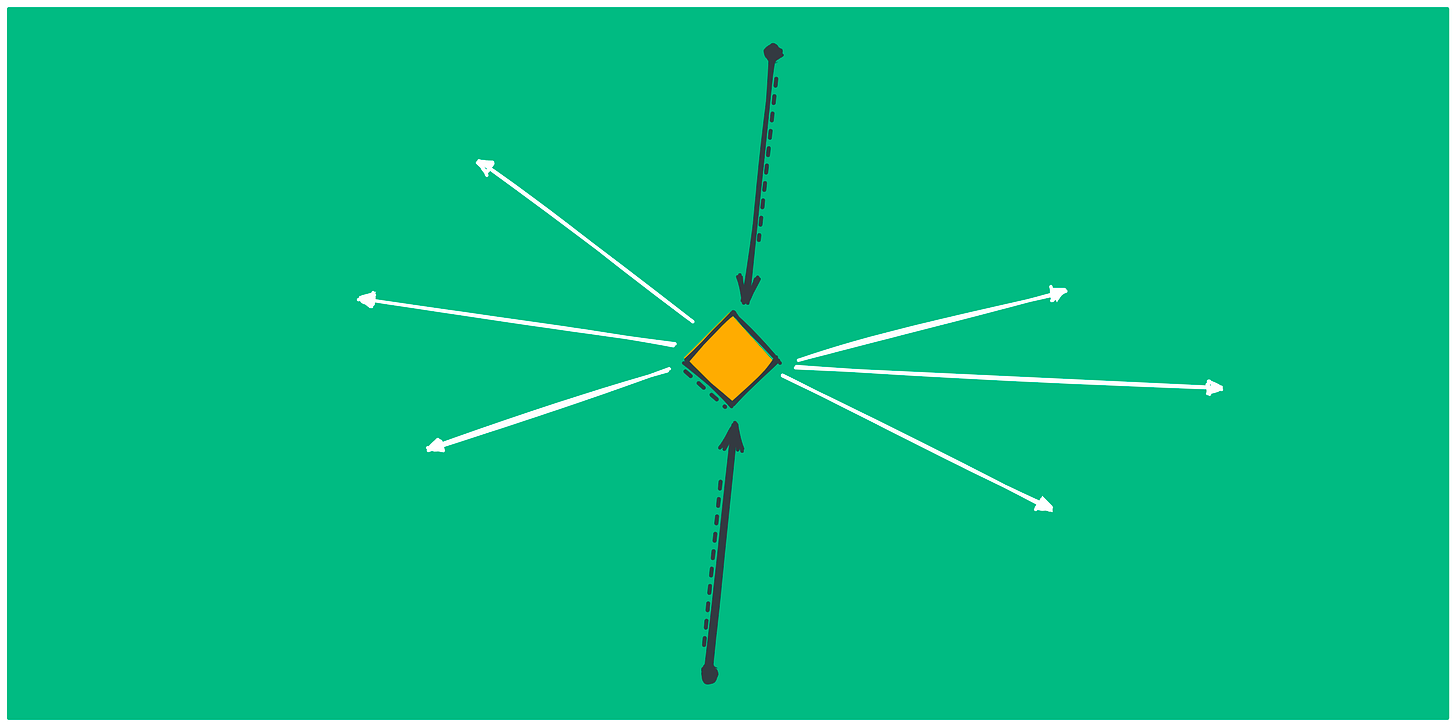Top-down, bottom-up, and everything in-between
Balancing strategic work with day-to-day work for a B2B product-led company.
When a company reaches 50+ people (or sooner), things start to get complex. Departments are starting to form, and each one has different KPIs, targets, and incentives. What was just product engineering became Sales, Marking, Community, and Support. You begin hearing executives talking about budget and the “corporate strategy”. At this point, many tech startups feel a bit uncomfortable. They are used to a bottom-up approach where things happen naturally, and direction can be decided quickly.
The good news are, you do not have to lose your bottom-up approach. Balance it with a few (very few) solid and clear top-down strategies.
When you have to shoot, shoot. Don't talk.
"Plan and prepare for every possibility, and you will never act. It is nobler to have courage as we stumble into half the things we fear than to analyze every possible obstacle and begin nothing. Great things are achieved by embracing great dangers."
— Xerexes (maybe)
There is a tendency for leaders to be obsessed with strategies, but the simple truth is that many things don’t need any strategy. The team will work for a few weeks just to develop the exact same actions they knew they needed to do.
Save your strategy work for the really complex work that needs research and coordination with other departments.
But how can you decide what "first things" to do?
The business impact is evident and significant. (10% more subscriptions, close 3 large clients, reduce support pressure by 30%)
The engineering impact is evident and significant. (Increase productivity by 10%, Reduce bugs by 25%)
Red flag for engineering or product standards. (Developers can’t deploy quickly, Users don’t understand how to use the product)
Everyone in the company knows about it and wants to do it. (The way we do X sucks)
Make the Top-down worth it.
Now that you addressed your "first things” (I urge you to do them before any strategic work), it’s time to think of your engineering strategy. You are not alone, and you must acknowledge this. As engineering has a massive impact on the success of your startup, your decision will impact every other department. If you only focus on scalability, you might ignore that new feature sales desperately need to reach their targets.
One team, one goal
Prioritize your company's few strategies holistically. Seat down with your leadership team and ask them, “What are your goals, and how are you planning to get there?”. Pick one of the many fantastic techniques to achieve this (OKRs or Opportunity-Solution Trees) and be sure to know what your fellow department is aiming for.
Use a collaborative method rather than a validation mechanism - Rather than working in silos and submitting your strategy for approval at the end, have collaborative sessions to discuss things together and create short loop feedback even when you are not sure.
Before, after, or in the middle?
Once streams are moving, aligning them is much more challenging, but by adjusting their initial azimuth you can avoid a lot of friction. As is true of everything in nature, every friction caused by a direction change will deplete your team's energy. Startups require efficiency at every turn.
Your meeting with the leadership will help you determine the azimuth that is most appropriate, to begin with. Of course, you will need to keep monitoring the location of your department and make adjustments.
Commit to Focus
Usually, at this stage, the department will have 5-6 strategies in place that attempt to address all the critical issues. Sounds reasonable, doesn't it? No, that's just too much top-down direction. Choosing 1-2 is the most effective way to make top-down worthwhile. Push the rest.
Win 1-2 strategies, and then move on. It is easy to preach focus, but only by focusing your team's attention on the right strategy will you truly make a difference.
To achieve bottom-up, one must work
Top-down can only bring you to a certain point, but bottom-up separates the most successful organizations where individuals lead innovation and hold up the product standards.
This post isn't going to focus on how to empower the team (maybe in a separate post), but I will mention some things that are often considered a strategy but are actually bottom-up.
Direction and vision
People link vision/direction documents with strategies, and it’s not wrong. The vision is critical for starting the discussion, but ultimately they are incredibly impactful for individuals in their day-to-day work.
Your strategies are focused on bringing you a specific outcome, but meanwhile, the team must keep working on the day-to-day. A well-defined direction will help engineers raise those red flags and identify high-impact work that wasn’t part of the strategy. Someone might bring to the table a fantastic opportunity they found out about.
In order to assist your team in identifying an opportunity, including both good and bad signals in your vision, for example:
Direction:
System usability improvements — we will raise the bar for system usability and level of quality.
Signals:
- Bad: We must write articles on how to use the system.
- Good: Features are adopted quickly.
- Bad: We often get “false bugs” because of misunderstandings.
If there is no law, you can't break it.
Another piece that can drive your engineers is standards. Setting the expectation for quality, success, velocity, values, and basically, anything you care about, your team can spot gaps and surface opportunities or pain points. The key to creating this culture is actually to do something when things come up. If your answer is always “not a priority,” at some point, people will stop coming to you.
Here are a few things you can do if you liked the article:
1) Share — Spread the word about this article to someone who may find it helpful.
2) Comment — Feel free to share your thoughts, questions, or simply your take on things!
3) Subscribe — If you haven't done so yet!





